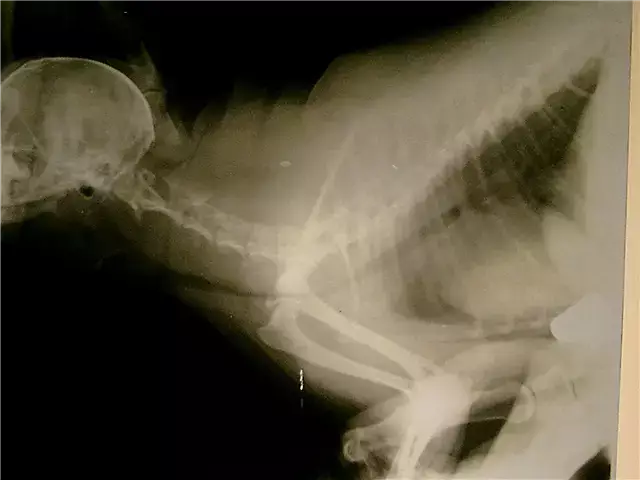- Author Rachel Wainwright [email protected].
- Public 2023-12-15 07:39.
- Last modified 2025-11-02 20:14.
Hexamidine
Instructions for use:
- 1. Release form and composition
- 2. Indications for use
- 3. Contraindications
- 4. Method of application and dosage
- 5. Side effects
- 6. Special instructions
- 7. Drug interactions
- 8. Analogs
- 9. Terms and conditions of storage
- 10. Terms of dispensing from pharmacies

Hexamidine is a drug of anticonvulsant and mild hypnotic action.
Release form and composition
Hexamidine is available in the form of tablets: flat-cylindrical, white, beveled; tablets of 250 mg are at risk (10 pcs. in blisters, in a cardboard box of 1, 2, 3, 4 or 5 packs).
Composition of 1 tablet:
- active substance: primidone - 125 mg or 250 mg;
- auxiliary components: sodium starch glycolate, calcium stearate, potato starch, polyvinylpyrrolidone type "Kollidon 90 F".
Indications for use
Hexamidine is used for essential tremor and epilepsy of various origins, manifested mainly in large seizures.
The drug is also prescribed for myoclonic, focal and akinetic seizures, but in this case it is less effective.
Hexamidine can be used as part of a complex anticonvulsant treatment.
Contraindications
- diseases of the hematopoietic system;
- kidney and / or liver disease;
- During pregnancy and breastfeeding;
- hypersensitivity to primidone or auxiliary components.
Hexamidine is prescribed with caution to children, debilitated patients and the elderly.
Method of administration and dosage
The tablets are intended for oral administration after meals.
The dose of Hexamidine is set individually for each patient. Treatment begins with a single single dose of 125 mg, after which the daily dose of the drug is increased every three days by 125 mg (for children under 9 years old) or 250 mg (for children over 9 years old and adults) until the required therapeutic effect is achieved.
Maximum daily doses: for adults - 1500 mg, for children - 1000 mg (in two divided doses).
Side effects
- digestive system: vomiting, nausea;
- central nervous system: headache, apathy, dizziness, drowsiness, anxiety; rarely - ataxia, nystagmus, psychotic reactions;
- hematopoietic system: rarely - lymphocytosis, leukopenia; isolated cases - megaloblastic anemia;
- other reactions: allergic reactions; rarely - arthralgia, lupus-like syndrome.
special instructions
Cancellation or replacement of Hexamidine with another drug is carried out gradually, since drug dependence may develop with prolonged treatment.
If megaloblastic anemia occurs, Hexamidine should be discontinued and vitamin B 12 and / or folic acid should be taken.
With prolonged therapy with anticonvulsants, it may be necessary to prescribe an additional amount of vitamin D, which is necessary to prevent osteomalacia.
There is evidence of a possible relationship between the use of anticonvulsants and an increased incidence of congenital malformations.
The drug is prescribed with caution to patients who are engaged in activities that require increased attention and quick response (driving a car, working as an operator or dispatcher, etc.).
Drug interactions
With the combined use of Hexamidine and acetazolamide, the effectiveness of primidone decreases, and rickets and osteomalacia are also possible.
Valproic acid can increase, decrease or not alter the plasma concentration of primidone at all.
Clonazepam increases the plasma concentration of Hexamidine. Primidone, in turn, can increase the plasma concentration of phenobarbital.
Analogs
Analogs of Hexamidine are: Deoxyphenobarbitone, Lepidin, Liscantin, Lespiral, Misolin, Mizodin, Mizolin, Milepsin, Primaklon, Primolin, Primidon, Prizolin, Prilepsin, Sertan, Sedilen.
Terms and conditions of storage
Store in a dry place at room temperature. Keep out of the reach of children.
The shelf life is 5 years.
Terms of dispensing from pharmacies
Dispensed by prescription.
Information about the drug is generalized, provided for informational purposes only and does not replace the official instructions. Self-medication is hazardous to health!






